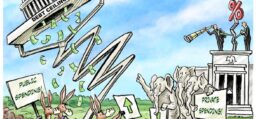Unrestrained spending would crowd out private economic activity and risk triggering a recession.
May 21, 2023 5:04 pm ET
House Speaker Kevin McCarthy last month mustered the votes for a bill to raise the debt ceiling, thanks in no part to his Democratic colleagues. His victory shifted the topography of the debt-ceiling battlefield and passed pressure onto the Senate and the White House. So far their response has consisted mostly of hot air. President Biden has called the House GOP’s bill “wacko” and Senate Majority Leader Chuck Schumer has said that its adoption would mean “real pain for American families.”
Messrs. Biden and Schumer evidently think the bill’s policy and spending reforms—i.e., tying welfare payments to work and capping annual growth in discretionary spending—are unreasonable. Yet the reasonableness of the House debt-ceiling provisions can be judged only by comparing them with how much of the federal government’s gusher of pandemic spending would otherwise become a permanent part of the post-pandemic budget.
While Democrats are preoccupied with who will lose the benefits of higher spending, the real debate requires looking at the private spending the Fed will have to crowd out with higher rates if federal spending isn’t constrained. The clean debt-ceiling increase the White House is pitching would give us more federal spending, tighter Fed policy and higher interest rates—all of which would crowd out private investment, sacrifice private jobs, and increase the risk of a recession.
Of the $5 trillion of stimulus payments between 2020 and 2022, some $362 billion has yet to be spent. The House debt-limit bill proposes to claw back $30 billion—or some 8% of the unspent balance. Only in Mr. Biden’s White House and Mr. Schumer’s Senate Democratic Caucus could such a modest proposal be considered extreme.
Before the pandemic, the Congressional Budget Office in January 2020 projected that total discretionary outlays in fiscal 2024 would grow to $1.549 trillion—which, adjusted for higher inflation, amounted to $1.694 trillion. The most recent CBO estimate projects that fiscal 2024 discretionary spending will clock in at $1.864 trillion—a 10% real increase from the pre-pandemic estimate. Nondefense outlays have risen 18.8% over the same period, while defense outlays have fallen 0.28% in after-inflation dollars.
This growth in nondefense discretionary spending is the post-pandemic bow wave that Mr. McCarthy’s debt-limit plan seeks to mitigate. Even if the House GOP’s proposed reductions in discretionary-spending growth took effect, total discretionary spending would still be 2.4% more in inflation-adjusted dollars than the CBO’s 2020 projection for fiscal 2024. Given that the alternative to spending restraint is the Federal Reserve’s hiking rates to crowd out private investment and risking recession, it’s the Democrats who increasingly seem unreasonable.
Moreover, while the House debt-ceiling bill proposes spending constraints over the next decade, the current Congress can’t bind a future Congress’s actions on discretionary spending. The proposals therefore are guidelines, not mandates: The House bill would constrain spending for 2024, but outlays thereafter will be set by the next Congress and the president after the elections.
The House GOP’s bill would also restore and expand the work requirements for welfare that Congress enacted and Bill Clinton signed in 1996. Since 1967, average inflation-adjusted transfer payments to low-income households—the bottom 20%—have grown from $9,677 to $45,389. During that same period, the percentage of prime working-age adults in the bottom 20% of income earners who actually worked collapsed from 68% to 36%.
While the 1996 welfare-reform law was a resounding success, generating a surge in employment and a decline in welfare rolls, much of its effectiveness was offset by work-requirement waivers granted during the Obama administration and the pandemic. The effect of welfare reform was further limited by the explosion of other welfare benefits—such as food stamps and refundable tax credits. The work requirement applied only to the Temporary Assistance for Needy Families program.
The House debt-ceiling bill would restore the Clinton-era work requirements for TANF and apply them to the federal food-stamp and Medicaid programs. Massachusetts Sen. Elizabeth Warren said she believes work requirements are “despicable.” But given that then-Sen. Biden voted for the Clinton welfare-reform bill and that the public overwhelmingly supports such requirements today—one recent survey found that three-fourths of voters support them for able-bodied adults—it’s going to be difficult to get the public to believe that work for welfare is diabolical.
The explosion of spending during the pandemic sent the inflation rate to a 40-year high and slashed the real wages of American workers. Now, Congress’s failure to rein in post-pandemic spending is denying the Fed a legislative partner in restraining inflation and forcing the central bank to tighten credit, choke off private-sector spending and heighten the risk of a recession. Is America really better off having the Fed stymie private spending instead of Congress clawing back unspent pandemic balances and constraining the magnitude of the post-pandemic spending surge?
In reality, this isn’t a debate about spending but about who is going to do the spending. A clean debt-ceiling hike would give us more government spending, and the House GOP’s proposal would allow more private spending. Only in Washington is that a hard choice.
Mr. Gramm, a former chairman of the Senate Banking Committee, is a visiting scholar at the American Enterprise Institute. Mr. Solon is an adviser to US Policy Metrics.





